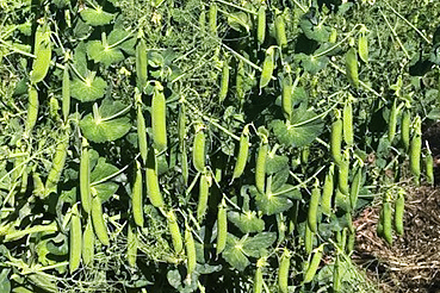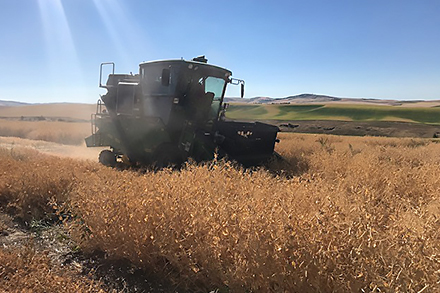ARS Releases First USDA Winter Peas for Food, Not Feed
Contact: Kim Kaplan
Email: Kim Kaplan
December 6, 2022—USDA MiCa, USDA Dint and USDA Klondike, the first winter pea cultivars specifically developed to be used whole or as an ingredient in human food, have been released by the Agricultural Research Service.
Winter or autumn-sown peas (Pisum sativum)—also called "black peas" or "field peas"—are annual legumes with excellent nitrogen-fixing abilities. They, and related pea species, originated in the eastern Mediterranean and western Asia. They should not be confused with cowpeas (Vigna unguiculata), which are also known as field peas, and usually grown in the southern states.
Currently, winter peas are mostly grown in the Pacific Northwest as a cover crop to add nitrogen to farmers' fields, for domestic animal feed and to attract deer and other game species. They also are sometimes used in a crop rotation with winter wheat in semi-arid areas of the Pacific Northwest.
"With a typical rotation of winter wheat–summer fallow, farmers really need a broadleaf crop to improve the sustainability of the system. Still, until now winter peas haven't provided enough of a return to be a cash crop," explained geneticist Rebecca McGee with the ARS Grain Legume Genetics Physiology Research Unit in Pullman, Washington. "Fall-sown, food quality, winter peas are poised better to fill that gap biologically and economically."
 USDA-ARS is introducing its first winter pea varieties developed for use in foods for people to eat rather than as animal feed. (Photo by Rebecca McGee, ARS).
USDA-ARS is introducing its first winter pea varieties developed for use in foods for people to eat rather than as animal feed. (Photo by Rebecca McGee, ARS).
But winter peas have much more potential value as an ingredient for human foods. These three new varieties offer several prized qualities: 1) high protein levels with a nearly complete amino acid profile 2) peas lack the allergens common in soybeans and peanuts, which are often the supplier of protein 3) a favorable, low glycemic index number and 4) winter peas are not genetically modified, all of their development is being done with traditional breeding.
As a food ingredient, the winter peas can be used to provide the protein in protein-starch-fiber slurries used as part of producing nondairy milk, energy bars, non-wheat flour pastas, and baked goods. Some of the food products that contain pea protein as an ingredient include Beyond Meats, numerous brands of protein powder, and many trail mixes.
Winter Austrian peas were first introduced to the Pacific Northwest, primarily in Idaho, in 1932. When World War II curtailed the availability of nitrate fertilizers, many farmers turned to winter Austrian peas as a replacement to add nitrogen to their soil. But the small, dark colored peas were not acceptable for human food use.
 Harvesting ARS' first winter pea varieties developed for human consumption rather than as animal feed. (Photo by Rebecca McGee, ARS).
Harvesting ARS' first winter pea varieties developed for human consumption rather than as animal feed. (Photo by Rebecca McGee, ARS).
"Still, U.S. regulations remained on the books that allowed only spring-planted peas to be sold in the food quality markets," explained McGee. "Once the regulations were changed in 2009 so the quality characteristics of the harvested seeds, not the planting season, dictated the purposes for which the crop can be sold, it allowed winter peas to enter the much more economically rewarding food quality distribution channels and opened the potential for widespread winter pea production."
McGee began her breeding program in 2010, selecting for human food-oriented traits.
The three new varieties:
- MiCa: A cross of a USDA winter pea with Arwyn, a spring pea with resistance to Pea Seed-borne Mosaic Virus that produces large, smooth green seeds. The name comes from combining the first letters of two of McGee's mentors in breeding winter peas.
- Dint: Produces large, smooth green seeds with a slight dimple. The name is from the Middle English word for a dent made by a blow.
- Klondike: Produces large, highly desirable dark yellow seeds invoked by the Klondike's connection to the gold rush era. Yellow seeds mean food producers don't have to remove color during processing.
The Agricultural Research Service is the U.S. Department of Agriculture's chief scientific in-house research agency. Daily, ARS focuses on solutions to agricultural problems affecting America. Each dollar invested in U.S. agricultural research results in $20 of economic impact.
